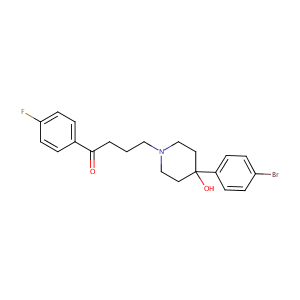Details of the Drug
General Information of Drug (ID: DM24XYQ)
| Drug Name |
Bromperidol
|
||||||||||||||||||||||
|---|---|---|---|---|---|---|---|---|---|---|---|---|---|---|---|---|---|---|---|---|---|---|---|
| Synonyms |
bromperidol; 10457-90-6; Impromen; Bromoperidol; Tesoprel; Azurene; 4-(4-(4-bromophenyl)-4-hydroxypiperidin-1-yl)-1-(4-fluorophenyl)butan-1-one; UNII-LYH6F7I22E; Bromperidolum [INN-Latin]; R 11333; EINECS 233-943-3; 4-(4-(4-Bromophenyl)-4-hydroxypiperidino)-4'-fluorobutyrophenone; CC 2489; BRN 1552256; LYH6F7I22E; 4-(4-(p-Bromophenyl)-4-hydroxypiperidino)-4'-fluorobutyrophenone; RKLNONIVDFXQRX-UHFFFAOYSA-N; 4-(4-(4-Bromophenyl)-4-hydroxy-1-piperidinyl)-1-(4-fluorophenyl)-1-butanone; NCGC00016692-01; CAS-10457-90-6
|
||||||||||||||||||||||
| Indication |
|
||||||||||||||||||||||
| Drug Type |
Small molecular drug
|
||||||||||||||||||||||
| Structure |
 |
||||||||||||||||||||||
| 3D MOL | 2D MOL | ||||||||||||||||||||||
| #Ro5 Violations (Lipinski): 0 | Molecular Weight (mw) | 420.3 | |||||||||||||||||||||
| Logarithm of the Partition Coefficient (xlogp) | 3.3 | ||||||||||||||||||||||
| Rotatable Bond Count (rotbonds) | 6 | ||||||||||||||||||||||
| Hydrogen Bond Donor Count (hbonddonor) | 1 | ||||||||||||||||||||||
| Hydrogen Bond Acceptor Count (hbondacc) | 4 | ||||||||||||||||||||||
| ADMET Property |
|
||||||||||||||||||||||
| Chemical Identifiers |
|
||||||||||||||||||||||
| Cross-matching ID | |||||||||||||||||||||||
Molecular Interaction Atlas of This Drug
 Drug-Metabolizing Enzyme (DME) |
|
||||||||||||||||||||||||||||||||||||
|---|---|---|---|---|---|---|---|---|---|---|---|---|---|---|---|---|---|---|---|---|---|---|---|---|---|---|---|---|---|---|---|---|---|---|---|---|---|
 Drug Off-Target (DOT) |
|
||||||||||||||||||||||||||||||||||||
| Molecular Interaction Atlas (MIA) | |||||||||||||||||||||||||||||||||||||
References
